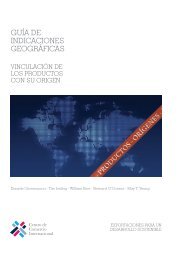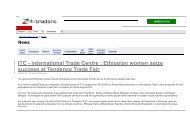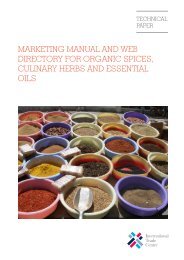Gender Mainstreaming: The Role Entrepreneurs Can Play and Why ...
Gender Mainstreaming: The Role Entrepreneurs Can Play and Why ...
Gender Mainstreaming: The Role Entrepreneurs Can Play and Why ...
You also want an ePaper? Increase the reach of your titles
YUMPU automatically turns print PDFs into web optimized ePapers that Google loves.
<strong>Gender</strong> <strong>Mainstreaming</strong>:<br />
<strong>The</strong> <strong>Role</strong> <strong>Entrepreneurs</strong> <strong>Can</strong> <strong>Play</strong> <strong>and</strong> <strong>Why</strong> It is Important<br />
Introduction<br />
With respect to the role that entrepreneurs can play in ‘gender mainstreaming’, it is more<br />
accurate to think in terms of ‘partnering’ <strong>and</strong> of women accessing ‘spheres of influence’.<br />
Often women are excluded from traditional or mainstream organizations, networks, events,<br />
business opportunities, jobs or even statistics because they are not visible, their contribution<br />
is unknown much less unrecognized or they are simply forgotten! Sometimes, omission of<br />
women is intentional <strong>and</strong> sometimes it is just negligence or ignorance. In simplistic terms,<br />
think of ‘gender mainstreaming’ as just a more strategic evolution of networking.<br />
What is <strong>Gender</strong> <strong>Mainstreaming</strong>?<br />
‘<strong>Gender</strong> mainstreaming’ is a formally recognized, widely used <strong>and</strong> highly technical term<br />
which can have a variety of meanings. In general, “gender mainstreaming” means that<br />
women <strong>and</strong> men have equitable access to <strong>and</strong> benefit from society’s resources, opportunities<br />
<strong>and</strong> rewards <strong>and</strong> equal participation in influencing what is valued, <strong>and</strong> in shaping directions<br />
<strong>and</strong> decisions. 1 It also refers to the integration of a gender perspective or awareness into the<br />
way in which a society or organization operates. In reference to women-owned service<br />
businesses, “gender mainstreaming” refers to support activities that are integrated into<br />
government <strong>and</strong> association policy <strong>and</strong> operations. All too often, initiatives to assist small<br />
businesses focus only on businesses owned by men, <strong>and</strong> initiatives specifically to help<br />
women are isolated from ongoing programming.<br />
<strong>Gender</strong> mainstreaming involves the full participation of women in all aspects of life <strong>and</strong><br />
addresses access issues to increase women’s participation in sectors where they are<br />
weakly represented. With respect to businesswomen, this is often in the area of export,<br />
international trade <strong>and</strong> trade missions. At the core of “gender mainstreaming” is a<br />
commitment to change attitudes so that women <strong>and</strong> men are equal participants in any<br />
initiatives for the private sector <strong>and</strong> to adopt gender-sensitive indicators for the purpose of<br />
ongoing monitoring <strong>and</strong> evaluation of gender mainstreaming.<br />
One of the most important principles to remember when discussing gender mainstreaming<br />
<strong>and</strong> developing a strategy to integrate businesswomen into main stream networks, is that it<br />
should never be confrontational. <strong>The</strong> idea is not an ‘either / or’ situation but to realize that<br />
what is good for women in business is good for all business <strong>and</strong> that by working together<br />
equally with businessmen <strong>and</strong> having the same opportunities, then the economy, business<br />
<strong>and</strong> development will be better for all.<br />
1 Gibb, Heather, <strong>Gender</strong> <strong>Mainstreaming</strong> Good Practices from the Asia Pacific Region, <strong>The</strong> North-South Institute, 2001<br />
54-56 rue de Montbrillant Postal address: Palais des Nations Telephone: +41 22 730 01 11 E-mail: itcreg@intracen.org<br />
CH-1202 Geneva, Switzerl<strong>and</strong> CH-1211 Geneva 10, Switzerl<strong>and</strong> Fax: +41 22 733 44 39 Internet: http://www.intracen.org
INTERNATIONAL TRADE CENTRE UNCTAD/WTO Page 2<br />
<strong>Why</strong> is <strong>Gender</strong> <strong>Mainstreaming</strong> Important?<br />
For women to grow their businesses <strong>and</strong> exp<strong>and</strong> in an increasingly competitive world, they<br />
have to have equal access to the opportunities, support <strong>and</strong> benefits that male owned<br />
businesses have. While women focused business associations <strong>and</strong> networks can be very<br />
helpful <strong>and</strong> supportive to women owned service businesses <strong>and</strong> women often start their<br />
businesses by providing services to other women owned businesses, it is crucial that<br />
women become integrated into the Chambers of Commerce, professional networks,<br />
associations, trade initiatives <strong>and</strong> trade opportunities that men have access to. Being<br />
recommended by male colleagues or being active in ‘mainstream’ networks can<br />
automatically increase the credibility of women owned service businesses <strong>and</strong> broaden<br />
their markets.<br />
When women entrepreneurs are included in mainstream fora, chambers, discussions <strong>and</strong><br />
networks, <strong>and</strong> research, they have a profound influence in a variety of ways. Participation<br />
brings increased awareness of the role <strong>and</strong> success of women. It increases the visibility of<br />
women <strong>and</strong> increases the potential for more business <strong>and</strong> growth. Participation of women<br />
entrepreneurs can influence the way new policy is made <strong>and</strong> alter government programs<br />
so that they do not exclude or hinder women entrepreneurs. Discussions at conferences<br />
take on a different tone <strong>and</strong> become more relevant to the needs of women entrepreneurs.<br />
Women are interesting! <strong>The</strong>ir businesses are interesting. <strong>Why</strong> exclude willing players<br />
who want to make a positive contribution? It is just more fun to have women involved!<br />
Recognizing the Barriers<br />
Barriers to women <strong>and</strong> their participation exist in a variety of ways: formal or implied.<br />
Typically, women entrepreneurs are excluded from mainstream networks, trade missions,<br />
conferences, associations, chambers <strong>and</strong> business development initiatives for economic<br />
reasons – the price is just to high to participate! <strong>The</strong> cost of joining or participating in<br />
events is often beyond what most small (hence women owned) businesses can afford.<br />
Even when women are willing to pay the entry price, they may deem that there are better<br />
uses of their money with a better return on their investments. <strong>The</strong> ‘culture’ of established<br />
networks can be intimidating <strong>and</strong> uninviting to women. Timing <strong>and</strong> venues of events may<br />
be inconvenient for women with families<br />
<strong>The</strong> <strong>Role</strong> That Women <strong>Entrepreneurs</strong> <strong>Can</strong> <strong>Play</strong><br />
<strong>Entrepreneurs</strong> can play a unique role in breaking down the barriers to women <strong>and</strong> increasing<br />
the full participation of women in business. By nature, entrepreneurs are innovative <strong>and</strong><br />
innovators who are risk takers! <strong>The</strong>y are leaders who are in a unique position to lead by<br />
example. <strong>Entrepreneurs</strong> are creative <strong>and</strong> want to do business! <strong>The</strong>y do not have to be<br />
bound by traditional rules but can make their own as they go along – entrepreneurs can<br />
create a whole new way of doing business! <strong>The</strong> most important thing that they can do is get<br />
involved. Become visible. Whether this is through networking or networks, the more visible<br />
<strong>and</strong> involved women are, the higher the potential to be ‘invited’ to participate in mainstream<br />
fora. Networking with men in positions of influence can be very effective, Leading women<br />
entrepreneurs can play a vital role in breaking down barriers for women who are not as<br />
visible – indeed they have a responsibility to speak for those who can not speak for<br />
themselves <strong>and</strong> to assist in accessing opportunities for more women. In order for women to<br />
break out of the cycle of small, local businesses, they have to have access to ‘the larger
INTERNATIONAL TRADE CENTRE UNCTAD/WTO Page 3<br />
market’ <strong>and</strong> this can be through chambers, conferences, trade missions, trade associations<br />
<strong>and</strong> businesses that have traditionally been more open to men.<br />
Large companies have a role to play in opening opportunities for women entrepreneurs as<br />
well. Women entrepreneurs are not only suppliers of goods <strong>and</strong> services, but we are also<br />
users of goods <strong>and</strong> services. We purchase raw materials, we bank at financial institutions,<br />
we use telephones, computers, couriers, office supplies, professional advisers – all the<br />
goods <strong>and</strong> services that any business uses. Individually our businesses may be small at<br />
the moment, but collectively we represent a very large <strong>and</strong> growing market.<br />
Who to ‘target’ – Spheres of Influence, Decision Makers, Potential<br />
Champions<br />
Look around to see who the leaders are: who do you want to target? Everyone knows<br />
who they are: the spheres of influence, the decision makers, the networks, but most of all,<br />
who can you enlist to be ‘champions’ for women entrepreneurs. Champions are found<br />
when you least expect it: other successful women, politicians, civil servants, high profile<br />
men, business people <strong>and</strong> they exist in the:<br />
v Public sector<br />
v Private sector<br />
v Associations <strong>and</strong> networks<br />
How To Do It – Get Involved<br />
<strong>Gender</strong> mainstreaming in the context of businesswomen is all about inclusion <strong>and</strong><br />
recognition. <strong>The</strong> best way to achieve this is to just get involved. <strong>The</strong> following are some<br />
general guidelines that are helpful:<br />
‣ Identify issues <strong>and</strong> why - what is it that you want to be included in <strong>and</strong> why<br />
aren’t women included? Often this is for economic reasons – if so, look for<br />
alternative. For example if it is too costly for women to join chambers or<br />
organizations then look for alternatives such as a woman representative or<br />
having an associate relationship through another organization such as a<br />
women’s organizations. If the conferences are too expensive to attend, then<br />
nominate women as speakers or even volunteers to assist in organizing,<br />
providing services or participation in promotion – the key is to get included <strong>and</strong><br />
get in the door;<br />
‣ Define desired outcomes – before you start, determine what is your desired<br />
outcome – is it women on trade missions, more women members, more women<br />
speakers, better policy for women, - determine the desired outcomes <strong>and</strong> be<br />
strategic in achieving them;<br />
‣ Show how the objectives will provide benefits for women – often the benefits to<br />
women are not instant or obvious so show how women can benefit from a more<br />
inclusive business community;<br />
‣ Show how the participation of women can be sought – as in the model illustrated<br />
below, it may be necessary to actually show how women can be identified <strong>and</strong><br />
solicited – when women are not part of the formal sector or business community,<br />
it is too easy to assume that they do not exist, or are not interested - therefore<br />
women have to be active in identifying each other;
INTERNATIONAL TRADE CENTRE UNCTAD/WTO Page 4<br />
‣ Provide a brief description of the way in which women can participate <strong>and</strong> add<br />
value – this may be obvious to women but not so obvious to the mainstream –<br />
when women try to change the status quo or become included, it can be<br />
threatening or deemed confrontational – this is to no-one’s advantage. By being<br />
strategic <strong>and</strong> showing how women can participate <strong>and</strong> the added value of<br />
participation, we create a scenario where everyone can win;<br />
‣ Get women be involved in decision making capacities – ultimately women want<br />
to be involved at the decision making level, especially in advocacy or when<br />
influencing policy. Women’s life <strong>and</strong> business experiences differ from men’s so<br />
their view will be different <strong>and</strong> needs to be represented;<br />
‣ Gather information on potential ‘partners’ – make sure that the partnering is<br />
logical <strong>and</strong> both will benefit. Resources are limited so strategic planning is key<br />
to success;<br />
‣ Do research <strong>and</strong> be well prepared. Know about the public sector or the private<br />
company or the network or association. Do your homework;<br />
‣ Develop/analyze options – partnering <strong>and</strong> penetrating into the mainstream<br />
business world will not happen overnight so women should have other options<br />
such as continued working together <strong>and</strong> development of their own networks <strong>and</strong><br />
businesses to increase their own visibility <strong>and</strong> success;<br />
‣ Make recommendations in a constructive way on how to include more women;<br />
‣ Communicate plans, business information, opportunities, research, promotion,<br />
successes of women entrepreneurs;<br />
‣ Evaluate how successful the initiatives to include women are? If they are not<br />
working or are not having any success, then evaluate why. Timing is critical <strong>and</strong><br />
giving time is critical. Perhaps methods or champions have to be amended;<br />
‣ Do not act in a threatening way – no one likes confrontation <strong>and</strong> no one likes to<br />
feel as if something (especially women!) are being forced on them;<br />
‣ Start at the top – this may sound elitist but leaders will bring along others <strong>and</strong><br />
help elevate all women – pick the champions wisely!<br />
‣ Publicize success of women - through awards <strong>and</strong> recognition such as:<br />
• Women Inventors <strong>and</strong> Innovators Awards<br />
• Women Entrepreneur of the Year Awards<br />
• Women of Achievement<br />
• Public Sector – government recognition programs<br />
• Private Sector – privately sponsored programs<br />
• Associations <strong>and</strong> networks – create recognition<br />
• Ensure that women are nominated for all awards
INTERNATIONAL TRADE CENTRE UNCTAD/WTO Page 5<br />
Women’s Trade Mission Model<br />
In 1997, the Government of <strong>Can</strong>ada organized the first businesswomen’s trade mission to<br />
the United States. This was developed by the collaborative efforts of the public sector<br />
(government – the Department of Foreign Affairs <strong>and</strong> International Trade, Industry<br />
<strong>Can</strong>ada, Export Development <strong>Can</strong>ada, Business Development Bank of <strong>Can</strong>ada) <strong>and</strong> the<br />
private sector (Royal Bank of <strong>Can</strong>ada, General Motors <strong>Can</strong>ada, IBM, Hodgson Russ law<br />
firm) <strong>and</strong> NGO’s (the Certified General Accountants Association of <strong>Can</strong>ada, the<br />
Foundation of <strong>Can</strong>adian Women <strong>Entrepreneurs</strong> <strong>and</strong> the National Association of Women<br />
Business Owners in the United States). This trade mission was brought about as a direct<br />
result of ‘champions’ in both the private <strong>and</strong> public sector who recognized that the<br />
participation of businesswomen in trade missions was dismally low. <strong>The</strong> government of<br />
<strong>Can</strong>ada assumed (incorrectly) that women were not interested in exp<strong>and</strong>ing internationally<br />
or doing business internationally or that their businesses were too small. <strong>The</strong> reality was<br />
that most women were never invited to participate on trade missions or new little if<br />
anything about the opportunities of doing business with <strong>Can</strong>ada’s greatest trading partner!<br />
When the government actively made an effort to identify potential participants <strong>and</strong> sought<br />
out the participation of women through a variety of contacts, associations, marketing <strong>and</strong><br />
referrals <strong>and</strong> the assistance of the private sector, they were overwhelmed. Hundreds of<br />
women made enquiries, several hundred applied <strong>and</strong> finally, more than 100 <strong>Can</strong>adian<br />
businesswomen participated in this groundbreaking event.<br />
<strong>The</strong> public <strong>and</strong> private sector together with two NGO’s collaborated to ensure a highly<br />
successful event. That trade mission, led by <strong>Can</strong>ada’s then Minister for International<br />
Trade, the Honourable Sergio Marchi <strong>and</strong> hosted by <strong>Can</strong>ada’s then Ambassador to the<br />
United States, His Excellency Raymond Chrétien, resulted in more than $30 million of joint<br />
partnerships <strong>and</strong> new business signed during the mission. A high profile media campaign<br />
was enacted <strong>and</strong> for the first time, women entrepreneurs engaged in roundtable<br />
discussions directly with the Minister. Business matching was organized <strong>and</strong> training<br />
workshops took place. <strong>The</strong> women involved had businesses which ranged from micro to<br />
large. Individually they employed from one to several hundred people, but when<br />
collectively these 100 women employed more than 8,000 people directly <strong>and</strong> 40,000<br />
indirectly <strong>and</strong> were responsible for more than $400 million in revenue (<strong>and</strong> they all voted!)<br />
At these figures, the Minister <strong>and</strong> the rest of the government <strong>and</strong> private sector began to<br />
listen. This model has been copied many times since. <strong>The</strong> objectives from the outset<br />
were not to exclude women from main stream trade missions but rather to do the following:<br />
include women entrepreneurs in international trade; show that there are women interested<br />
in exp<strong>and</strong>ing internationally; help educate women about doing business internationally in<br />
an environment that they were comfortable in; increase the participation of women in<br />
mainstream trade missions; <strong>and</strong> raise the overall profile of women entrepreneurs in<br />
<strong>Can</strong>ada. By all accounts this mission was a success. No one in <strong>Can</strong>ada today says that<br />
women entrepreneurs are not making a difference!<br />
Conclusion <strong>and</strong> Final Tips<br />
‣ Become aware of your community’s opportunities <strong>and</strong> protocol for inclusiveness.<br />
‣ Communicate with other organizations <strong>and</strong> learn about their interests <strong>and</strong> work<br />
towards building a coalition with them to achieve a greater visibility.<br />
‣ Make the female voice one of solutions not of complaints; focus on <strong>and</strong> find<br />
solutions that are responsive to real needs <strong>and</strong> be positive.
INTERNATIONAL TRADE CENTRE UNCTAD/WTO Page 6<br />
‣ Learn to use the media – keep in mind that you gain more through cooperating<br />
with the media than by trying to challenge them; use the media to reach decision<br />
makers <strong>and</strong> celebrate success.<br />
‣ When developing a strategy, it is good to ask, what different results in impact or<br />
opportunity will this initiative have, respectively on men <strong>and</strong> women.<br />
‣ Setting targets for women’s participation is effective.<br />
‣ Lead by example.
















